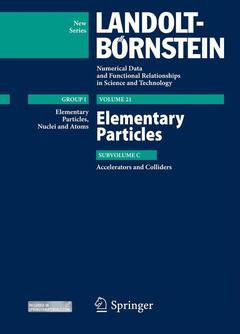Description
Elementary Particles - Accelerators and Colliders, 2013
Elementary Particles, Nuclei and Atoms Series
Authors: Amaldi Ugo, Angert Norbert, Bethge Klaus, Bordry Frederick, Herr Werner, Caspers Friedhelm, Delahaye Jean-Pierre, Fischer Wolfram, Forest Etienne, Goddard Brennan, Burkhardt Helmut, Guiducci Susanna, Hanke Klaus, Hinton Jim, Hofmann Werner, Holmes Stephen D., Hübner Kurt, Kadi Yacine, Lamont Michael, Assmann Ralph Wolfgang, Brüning Oliver, Garoby Roland, Steinhagen Ralph, Tomás García Rogelio, Wenninger Jörg, Bottura Luca Bottura, Jensen Erk, Jimenez Jose Miguel, Jones Owain Rhodri, Holzer Bernhard, Jowett John, Rivkin Leonid, Lindroos Mats, Metral Elias, Rumolo Giovanni, Oide Katsunobu, Roser Thomas, Rossbach Jörg, Dohlus Martin, Schmüser Peter, Willeke Ferdinand, Seeman John T, Grudiev Alexej, Krafft Geoffrey, Latina Andrea, Papapaphilippou Ioannis, Phinney Nanette, Ross Marc, Schulte Daniel, Seryi Andrei, Yamamoto Akira, Shiltsev Vladimir, Wilson Edmund J. N., Mertens Volker, Missiaen Dominique, Tavian Laurent Jean, Tommasini Davide, Burnet Jean-Paul, Brugger Markus, Caldwell Allen, Boine-Frankenheim Oliver, Magrin Giulio
Coordinators: Schopper Herwig, Myers Stephen
Language: English
Subject for Elementary Particles - Accelerators and Colliders:
Description
/li>Contents
/li>Comment
/li>
After a historical consideration of the types and evolution of accelerators the physics of particle beams is provided in detail. Topics dealt with comprise linear and nonlinear beam dynamics, collective phenomena in beams, and interactions of beams with the surroundings. The design and principles of synchrotrons, circular and linear colliders, and of linear accelerators are discussed next. Also technological aspects of accelerators (magnets, RF cavities, cryogenics, power supply, vacuum, beam instrumentation, injection and extraction) are reviewed, as well as accelerator operation (parameter control, beam feedback system, orbit correction, luminosity optimization). After introducing the largest accelerators and colliders of their times the application of accelerators and storage rings in industry, medicine, basic science, and energy research is discussed, including also synchrotron radiation sources and spallation sources. Finally, cosmic accelerators and an outlook for the future are given.
Accelarators, Colliders and Their Application.- Beam Dynamics.- Non-Linear Dynamics in Accelerators.- Impedance and Collective Effects.- Interactions of Beams With Surroundings.- Design and Princples of Synchrotrons and Circular Colliders.- Design and Principles of Linear Accelerators and Colliders.- Accelerator Technology.- Accelerator Operations.- The Largest Accelerators and Colliders of Their Time.- Application of Accelerators and Storage Rings.- Outlook for the Future.- Cosmic Particle Accelerators.




